What you'll learn
Written Exam covers the following contents:
- Chapter1: Basics of Alcoholic Beverages
- Chapter2: What is Awamori?
- Chapter3: The Origin of the Term “Awamori”
- Chapter4: What is Ku-su?
- Chapter5: Making Process of Awamori
- Chapter6: The History of Awamori
- Chapter7: The Awamori Flavor Wheel
- Chapter8: How to Enjoy Awamori (Drinking Methods and Glassware)
- Chapter9: How to Choose Your Favorite Awamori
- Chapter10: Distilleries and their Signature Awamori
Practical Exam covers the following contents:
How to taste awamori, and evaluate the quality, identity and maturation
Examination
1.Written exam
Written exam is assessed by an examination consisting of 30 multiple choice questions.
On the examiner’s signal, take the web-based test for each level using your own smartphone or other device.
If you have passed, raise your hand and present the passing screen to the examiner.
2. Practical exam
Practical exam is assessed by a blind tasting of three awamori.
The practical exam can only be taken by those who have passed the written exam.
Course Delivery
This certification requires a minimum of 30 hours of study time, including 2 hours of classroom or online delivery time with the Awamori Certification Exam provider*.
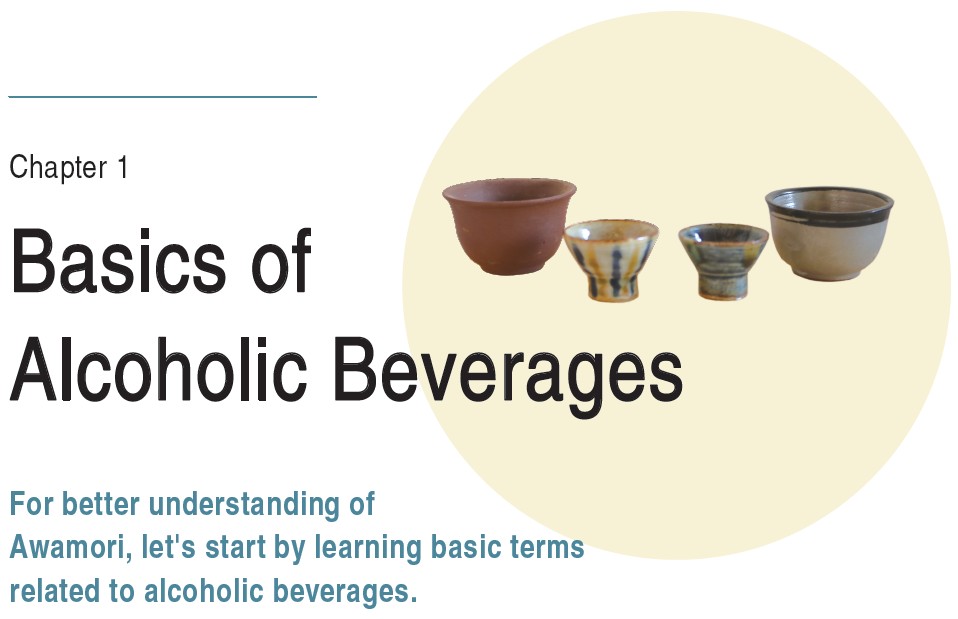
OSAKE – Alcoholic Beverages
According to the Liquor Tax Law in Japan, ‘sake’ is defined as “drinks with an alcohol content of 1% or more, or powdered substances that can be dissolved to produce a drink with an alcohol content of 1% or more.”
“Side note: In Japan, we often use the word ‘sake’ to refer to all alcoholic beverages: Nihon-shu, liqueurs, spirits, wine etc. This is because they share the same Kanji (酒).”
Glucose
This is a representative substance that serves as a primary energy source for living organisms. It is found in grains, fruits or sugar.
Starch
This is a substance composed of thousands of glucose molecules bonded together. In a broader sense, starch is a type of carbohydrate (sugar), but in the context of alcoholic beverages, the term “sugar” typically refers to glucose and other sugars that result from breaking down starch, rather than starch itself.
Yeast
This is a microorganism, roughly 1/200th of a millimeter in size, that has an oval shape. By creating a suitable growth environment, yeast converts sugars into alcohol through the fermentation process.
Alcohol Fermentation
This refers to the process where yeast converts sugars into alcohol and carbon dioxide. The alcohol in beverages is produced through this fermentation process carried out by yeast.
Saccharification
Saccharification is the preparation process where starches in grains are broken down into sugars to facilitate smooth alcohol fermentation by yeast.
Koji Mold
Koji mold is a microorganism that breaks down starch into smaller sugars during saccharification. There are various types of koji mold, but only black koji mold (Aspergillus awamori) is used in the production of awamori.
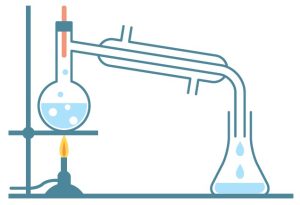
Brewed Alcoholic Beverages
Beverages produced through alcoholic fermentation are known as brewed alcoholic beverages. Examples include sake, beer, and wine.
Distillation
Distillation is a process that utilizes the fact that alcohol evaporates at a lower temperature than water. It involves heating a liquid containing alcohol, causing the alcohol to evaporate more readily. The alcohol vapor is then cooled and condensed back into a liquid, resulting in a liquid with a higher alcohol concentration.
Distilled Spirits
Distilled spirits are beverages that have undergone the distillation process. Examples include awamori, whiskey, brandy, rum, baijiu, gin, and vodka.
Go (180ml), Shō (1.8L), To (18L), Koku (180L)
In the world of Japanese alcoholic beverages, these are traditional Japanese units of liquor measurement. Approximately 1.8 liters is referred to as 1 Shō. One-tenth of a Shō is called 1 Go, ten times a Shō is 1 To, and ten times a To is 1 Koku. To summarize: “1 Koku = 10To = 100 Shō = 1,000 Go.”
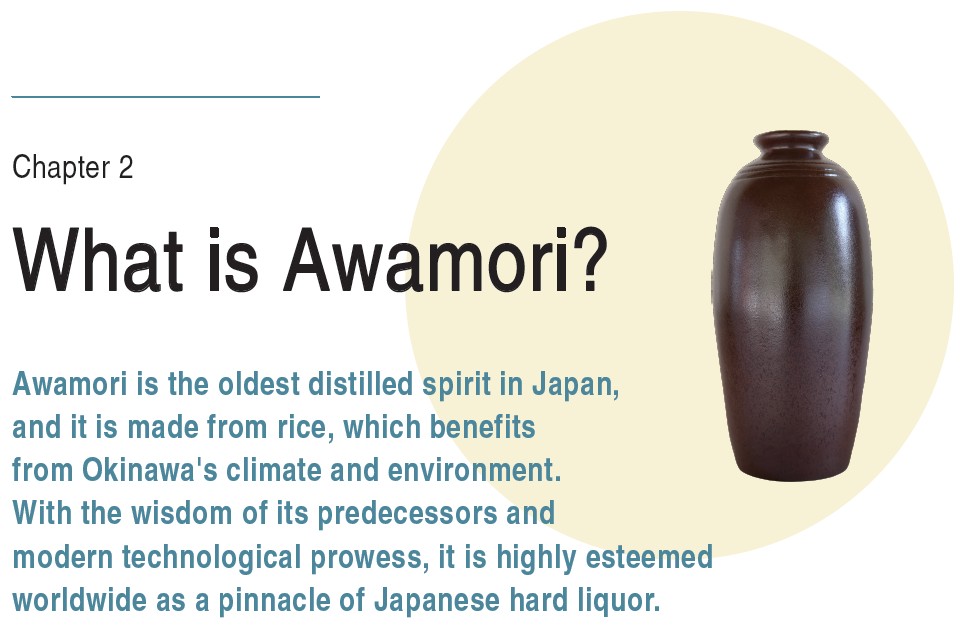
Awamori is cherished for its characteristics of rich aroma and smoothness developed through long-term aging. Awamori aged for 3 years or more is known as Ku-su (aged awamori) when it has matured properly. The aging process for Ku-su requires a long period of tranquility, which is why awamori is chosen as a symbol of peace and longevity. It is often selected as a precious gift for important individuals or as an offering to ancestors and deities, imbued with wishes for health and prosperity.
Awamori as a norm
As an origin of Japanese distilled spirit, awamori is subject to certain production constraints due to its historical roots.
1. Ingredient – “Rice”
Throughout its long history, except for the post-war period, awamori has always been considered “special” and is made solely from “rice,” which is a staple food for most Asian countries .
[Supplement: Rice for making Awamori]
Since the incorporation of the Ryukyu Kingdom into the Meiji government, the demand for awamori surged, prompting the expansion of rice sources to various parts of Asia. Today, Thai long-grain rice has become the predominant raw material. The practice of sourcing raw materials from the most suitable locations for each era highlights a unique feature of distilled spirits. Unlike brewed beverages, where the characteristics of the raw ingredients significantly affect the final product, distilled spirits rely more on processing techniques to produce high-quality liquor. Thai rice used for awamori is traded under national trade regulations, ensuring its safety and stability.
2. Production of awamori using a pot still
The production of awamori requires the use of a traditional pot still rather than a modern, large-scale column still, which focuses on efficiency in alcohol production. Sticking to pot stills ensures that awamori is distilled using methods that are rooted in tradition.
[Supplement: Column Still, Pot Still, and Authentic Shochu]
A column still is a device designed to distill alcohol-containing liquids continuously through a column divided into multiple layers. This method efficiently produces high-purity alcohol (ethanol). Introduced to Japan from overseas during the Meiji era for industrial alcohol production, column stills have since been used for manufacturing continuous distilled shochu or whiskey.
In contrast, a pot still features a simple structure with a heating section for the mash and a cooling section for condensing and extracting alcohol from the vapor. While the efficiency of alcohol purification is lower compared to column stills, pot stills allow more of the aromatic components to remain in the distilled liquid, resulting in a richer-flavored spirit. Only spirits distilled using pot stills are labeled as “Authentic shochu” in Japan.
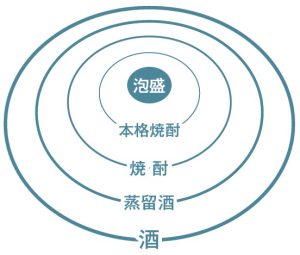
<図柄訳>
琉球泡盛 Ryukyu Awamori
泡盛 Awamori
本格焼酎 Honkaku Shochu
焼酎 Shochu
蒸留酒 Distilled Spirits
酒 Alcoholic Beverages
3. Only Black Koji Mold is Used
In the process of saccharifying rice starch, only black koji mold (Aspergillus Luchuensis) is used, which is traditional and well-suited to Okinawa’s climate.
[Additional Information: Roles of Black Koji Mold and Yeast]
In the production of shochu or other spirits besides awamori, Yellow koji mold (Aspergillus Oryzae) or White koji mold (Aspergillus Kawachii) is primarily used for saccharification. However, Black koji mold not only saccharifies starches but also produces a significant amount of citric acid. As a result, it increases the acidity of the mash, helping to suppress the spoilage of the mash by unwanted bacteria.
4. All Koji Making
Adding ingredients is allowed only once during the production process (All Koji Making). Unlike shochu, where ingredients are often added in multiple stages, awamori requires that all ingredients be added in one go.
5. Ryukyu Awamori Must Be Produced in Okinawa
Awamori can be produced anywhere in Japan as long as the production methods are being followed. However, to be labeled as “Ryukyu Awamori,” it must be produced within Okinawa Prefecture, according to the Geographical Indication (GI) protection system.
[Additional Information: Geographical Indication (GI)]
The Geographical Indication (GI) protection system is a national system that protects specific names of regional products developed under unique natural, cultural, and social conditions as intellectual property of the region.
6. Avoiding Excessive Coloring
When stored in wooden barrels/casks, awamori must not become too dark in color. If it turns darker than amber, reaching a deep brown color, it can no longer be labeled as awamori.
[Additional Information: Coloring Regulation]
While it’s not mandatory to remember, it is professionally recommended that when awamori is stored in wooden containers, the absorbance of light at wavelengths of 430 nanometers (nm) and 480 nanometers (nm) be measured. The coloring level should not exceed 0.080 for both wavelengths.
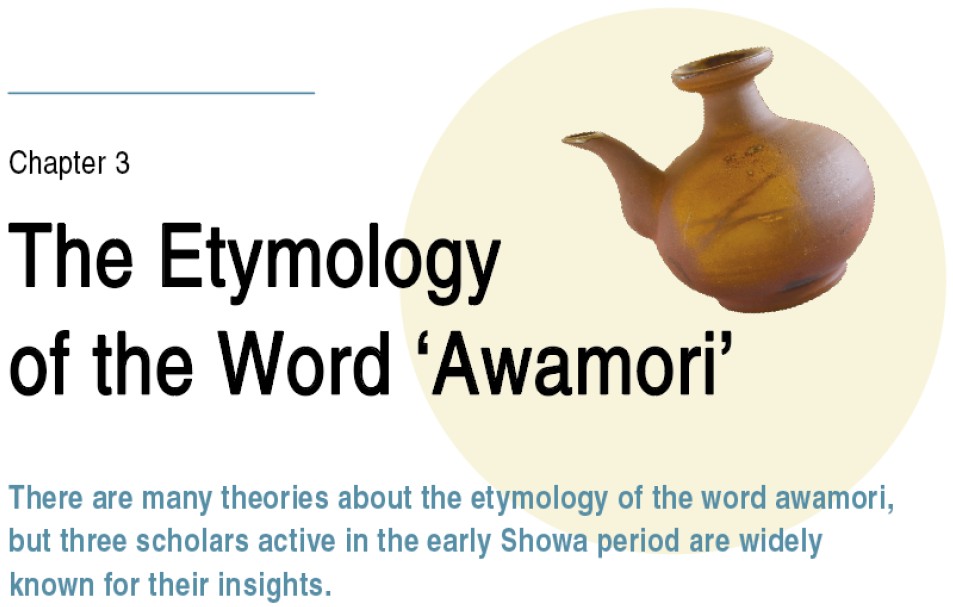
There are many theories about the etymology of the word awamori, but three scholars active in the early Showa period are widely known for their insights.
Fuyuu Iha’s theory (millet theory)
Fuyuu Iha, a pioneer in Okinawan research and also known as the ‘father of Okinawan studies’, noted that in the old Ryukyuan language the word for liquor was ‘mori’ and thought that the liquor made from millet, or awamori(millet means Awa in Japanese), eventually transformed into awamori.
For example, there is a sacred song (Omori) from the Northern part of Okinawa Prefecture, which says: ‘Awamori maamori, mamori rice maamori, akawan no onshiyagu, nakamori achihe, hatayorachihe’. This ‘awamamori’ refers to millet liquor, while ‘maimori’ refers to rice liquor.
Theory of Kanjun Higashionna (Formes theory)
The historian Kanjun Higashionna stated that there are two theories among Ryukyuan brewers, one that it was originally brewed from chestnuts and the other that the forms rise during the brewing process, but that the theory of forms during the brewing process makes more sense.
This is because whether the raw material is millet or rice, it is called “Awamori” in the mainland, while in the Ryukyus, where it was manufactured, it was not called “Awamori”, but saki (sake=liquor), yaki-shu/yaki-zaki or shochu, and the relationship between the raw material and the name is considered to be weak.
At the same time, the characteristic of the forms rising during fermentation could only be known to those involved, and the coined term ‘Awamori’ is not Ryukyuan, and furthermore, despite the name ‘Awamori’ appearing in the daily record of offerings to the shogunate, the name Awamori is not found in Ryukyuan records at the time, so it is considered that the name was probably given by a Satsuma liquor producers.
Chikaho Tanaka’s theory (Bubbles theory)
Chikaho Tanaka, a teacher at the Okinawa Prefectural Agricultural and Forestry School, introduced four theories on the origin of the word “Awamori”.
1. In the Seikei Zusetsu (an agricultural encyclopedia from the Edo period): ‘The Okinawan and Hokkaido use local millet to make distilled spirits. In Okinawa, it is called Awamori.’ The theory is that the raw material was millet, hence the name ‘Awa=Millet-mori’, which in turn became ‘Awa=Bubbles – mori’.
(both “bubbles” and “forms” means “Awa” in Japanese)
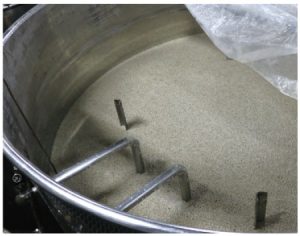
2. A theory, articulated by Dr Matsumura (details unknown), is that there was a term in Sanskrit (an ancient Indian language) for liquor pronounced ‘Awa-muri’, which came to be used for calling liquor in the Ryukyu Islands.
3. A theory is that when there were no alcohol meters, bubbles of liquor were heaped into a teacup and the state of the bubbles determined the alcohol content and price, hence the name Awamori (Bubble – mori).
4. A technique of soaking roasted millet in the distilled liquor to change the quality of the liquor was common, so the liquor treated in this way came to be called Awamori (millet-mori), which in turn became Awamori.
While he didn’t clearly declare which of these theories is correct, it was concluded that the theory that the name ‘Awamori’ came about because ‘bubbles/foam was served in the bowl’ during the price assessment is the most reasonable, without any unnaturalness or inconsistency.
Summary.
Fuyuu Iha: In ancient Ryukyuan, liquor was called ‘mori’. The word ‘Awamori’ is derived from the word ‘Awa=Millet-mori’ (liquor), which is made from millet.
Kanjun Higashionna: The name ‘Awamori’ was given by a Satsuma liquor producer because of the way the Awa=forms rise during brewing.
Chikaho Tanaka: ‘Awamori’ came to be used for ‘serving bubbles in a tea bowl’ during a price setting.
The actual word for ‘Awa-muri’ in Sanskrit, which is used in Chikaho Tanaka’s theory, has so far not been confirmed.
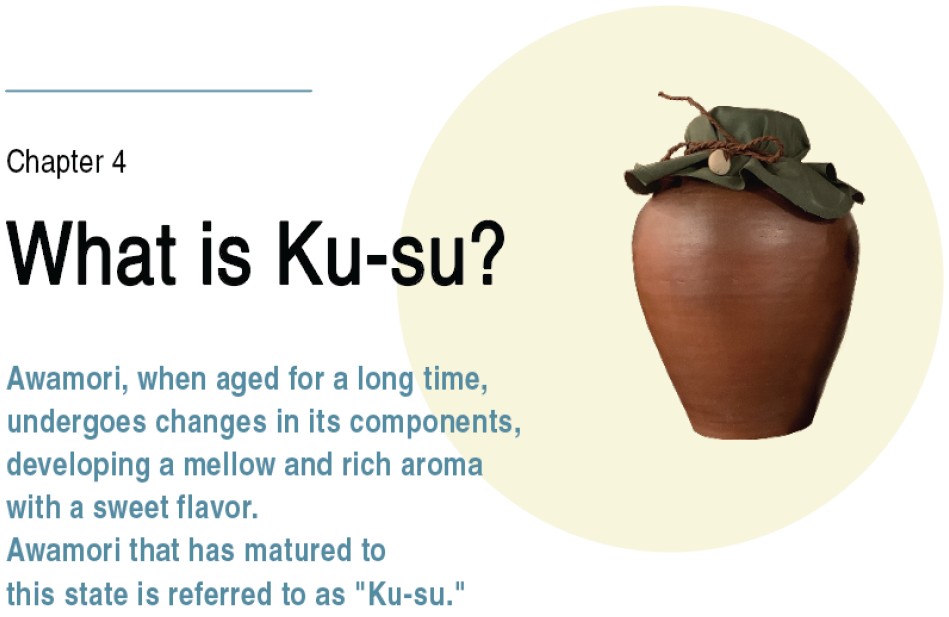
Ku-su making is practiced not only by awamori manufacturers but also among consumers, and there are various styles of aging.
The traditional method involves aging in ceramic jars (kame), and awamori aged this way is referred to as “Kame Ku-su.” Kame Ku-su could develop an unique aroma due to the extraction of minute components from the jar and evaporation, resulting in a distinct fragrance that varies from jar to jar.
Additionally, within the kame Ku-su tradition, there is a method called “Shitsugi” that involves aging awamori in multiple jars over a long period. This technique is passed down as a method for producing consistently high-quality Ku-su.
For example, if there are three clay jars, each containing Awamori aged for 20 years, 10 years, and 5 years respectively, the oldest 20-year-old liquor would be referred to as “ichiban-shu” (first liquor), the next oldest 10-year-old as “niban-shu” (second liquor), and the 5-year-old as “sanban-shu” (third liquor), with the numbers assigned according to their age.
When drinking Ku-su, you start by pouring out only the amount you intend to consume
from the ichiban-shu (first liquor). The amount reduced from the ichiban-shu is then replenished with the niban-shu (second liquor), and similarly, the amount reduced from the niban-shu is replenished with the sanban-shu (third liquor). Finally, fresh awamori is added to the sanban-shu. It is crucial to avoid over-extracting the ichiban-shu to maintain quality. In general, the amount extracted from the ichiban-shu should be around 10% of the jar’s contents per year .
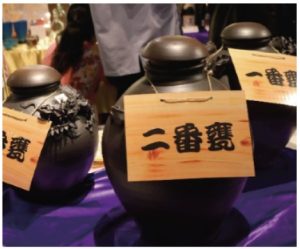
On the other hand, Ku-su aged in bottles is known as “bottle Ku-su.” Aging in bottles presents fewer risks of alcohol evaporation and microbial growth compared to jars, making it easier to manage. However, determining the optimal drinking time can be more challenging. Especially for awamori with a lower alcohol content. There is a peak period for drinking quality, after which it tends to lose its strength. As a general guideline, it is recommended to consume awamori with an alcohol content below 30% within 20 years, and for those above 40% ABV, it should be consumed or re-bottled within 30 years due to the degradation of the bottle cap.
Specifications for Ku-su (Aged Awamori)
According to the Fair Competition Code, which is an industry standard, to produce and sell awamori labeled as “Ku-su” (aged awamori, stored awamori, or matured awamori), the contents must be “stored for at least 3 years.”Additionally, when displaying the storage age of awamori, the code stipulates that it should indicate “the number of years stored as stated or more.” If different aged Ku-su are blended, regardless of the ratio, the age displayed should correspond to the least aged Ku-su. Storage periods less than the displayed number of years are to be rounded down and shown accordingly.
Aging Your Own Ku-su
One way to enjoy awamori is by making your own unique Ku-su (aged awamori). A key factor in this process is selecting awamori with a rich flavor profile, meaning it contains a high concentration of components other than alcohol. This choice ensures that after long-term aging, the resulting Ku-su will be aromatic and robust. For making Ku-su, it is generally recommended to use awamori with the following specifications: “35% alcohol or higher, distilled at atmospheric pressure, and not heavily filtered.” Although not always labeled, awamori marked as “coarse filtered,” “unfiltered,” or “for aging” is typically produced with the intention of being used for making aged Ku-su.
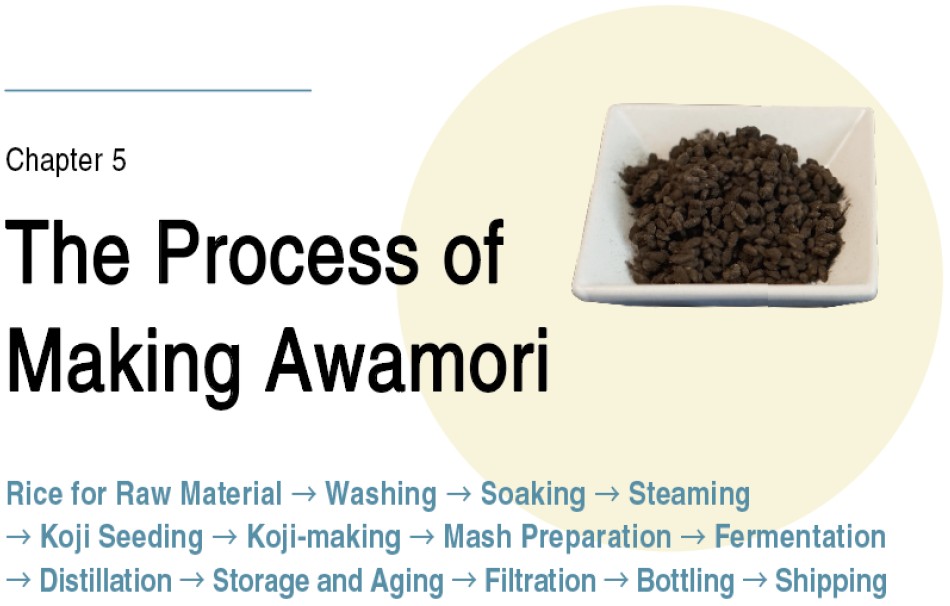
1. Rice for Raw Material
The rice used for making awamori is primarily long-grain rice from Thailand, except for a few brands. The rice can be used in its polished form (whole rice without husk) or crushed (coarse-ground polished rice).
2. Washing Rice
This process involves washing away the bran and other impurities on the surface of the rice. The rice is placed into a rotating drum where water is continuously flowing to wash it. For large quantities of rice, it is sometimes placed into a tank filled with water, which is then transported to the rotating drum while washing.
Note: The method of processing rice for awamori may vary depending on the type of steaming equipment used, but approximately 80% of distilleries use rotating drums.
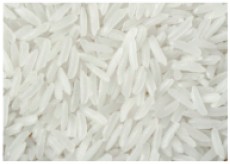
▲Long grain rice
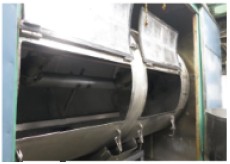
▲Rotating Drum
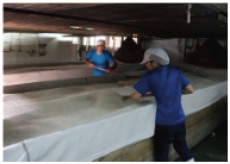
▲Koji Making Bed
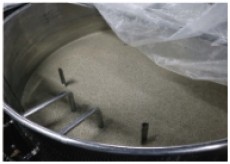
▲Fermentating Mash
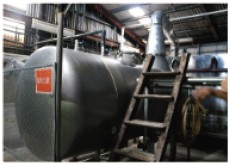
▲Pot Still
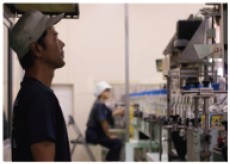
▲Bottling
3. Soaking
This is the preparatory step for steaming the rice, where the rice is soaked in water to ensure thorough hydration. The duration of soaking is determined based on the condition of the rice.
4. Steaming
In this step, steam is applied to the rice inside a rotating drum to cook it. The drum is rotated periodically to ensure even temperature distribution. The level of steaming is adjusted according to the desired outcome.
5. Koji Seeding
After cooling the steamed rice to around 40°C, black koji mold is sprinkled over it. In awamori production, it is common to use seed koji (rice with black koji mold already cultivated on its surface) for this process.
6. Koji Making (Seikiku)
This process involves propagating black koji mold to create rice koji. For awamori, which uses all of the rice as koji, the koji-making process is extremely important. The primary goal of propagating black koji mold is to produce enzymes that break down the raw materials and, additionally, to generate citric acid with preservative effects. When using a rotating drum, it is typical to perform the first half of the koji-making process inside the drum and then move to koji-making shelves (triangular shelves) for the latter half.
7. Mash Preparation
Rice koji is transferred to a fermentation tank, and yeast and water are added to generate alcohol. In awamori production, this process is done only once and is referred to as “zenkoji jikomi” (全麹仕込み), or all-koji fermentation.
8. Fermentation
During fermentation, the enzymes produced by black koji mold break down the rice starch into sugars, while yeast converts the sugars into alcohol. This mixture is known as “moromi” (the mash). The type of yeast used, the fermentation temperature, and the duration of fermentation all significantly impact the flavor of the awamori.
9. Distillation
In this process, the primary mash, which has reached an alcohol content of about 18%, is heated in a still to evaporate and concentrate the alcohol and flavor components. There are two types of distillation methods: the traditional “atmospheric distillation” and the “vacuum distillation”, where the air is removed from the distillation chamber to lower the boiling point of the liquid, allowing for distillation at lower temperatures.
10. Storage and Aging
After distillation, the liquid is stored for several months until its quality stabilizes before being shipped. The storage containers can vary, including clay jars, stainless steel tanks, enamel tanks, wooden barrels, and bottles. The flavor of the awamori changes depending on the storage period and the type of container used, becoming a key feature of the product. As previously mentioned, awamori aged for over three years is referred to as “Ku-su” (aged awamori).
11. Filtration and Bottling
The timing and method of filtration vary by distillery and product, but it is typically done either before or after storage. For packaging, bottling in glass is common, but other containers like clay jars, paper packs, PET bottles, and pouches are also used.
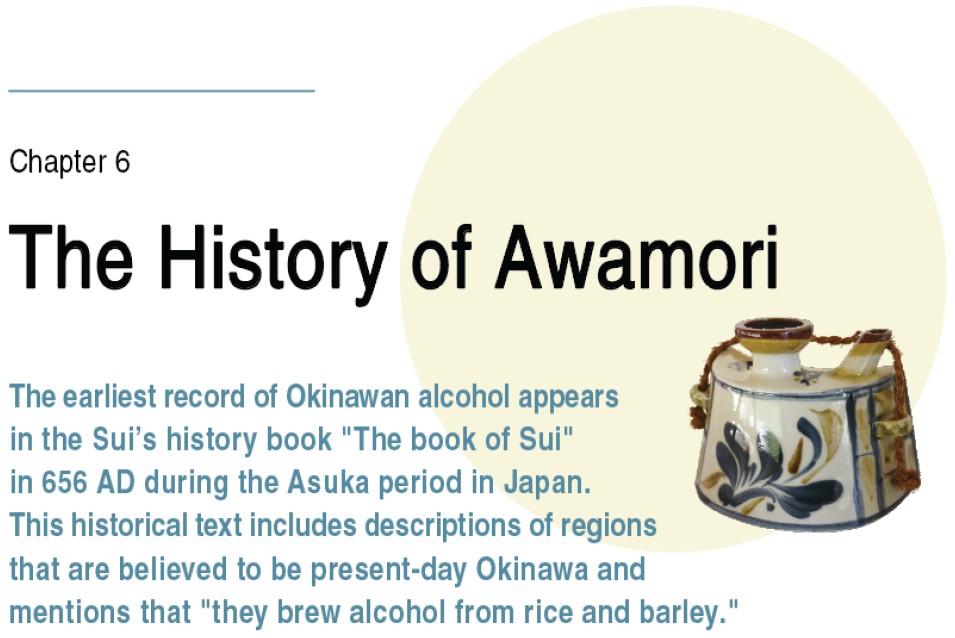
The timeline progresses to 1429, when Shō Hashi established the Ryukyu Kingdom in present-day Okinawa. During this period, several Koreans visited the Ryukyu Kingdom, and their records provide insights into that era.For example, in 1456, the Korean naval officer Ryang Seong reported that upon visiting Shuri, he observed that “the upper floors of Shuri Castle housed treasures, the middle floors were occupied by the king, and the lower floors contained alcohol and food.” Additionally, in 1461, shipwreck survivors including Seong Deok-Seong recorded that “at the port by the river, there was a castle with a liquor storage facility where large vats were lined up, filled with alcoholic beverages, and categorized into one-year, two-years, and three-years liquors.”
Furthermore, in 1477, Kim Bi-Ui and others who were shipwrecked on Yonaguni Island were eventually transported to Shuri after passing through places such as Hateruma Island, Aragusuku Island, Kuro Island, Tarama Island, Irabu Island, and Miyako Island. They noted that “Yonaguni had no clear liquor (distilled alcohol) and only turbid liquor (brewed alcohol). The turbid liquor was made by soaking rice in water, having women chew it into porridge, and then fermenting it in wooden barrels (Kuchikamizake). Irabu Island and Miyako Island had liquor made using rice koji. Naha had clear liquor, turbid liquor, and also Nanban liquor. The clear liquor was similar to Korean liquor.” In this context, “clear liquor” refers to the distilled alcohol made in the Ryukyu Islands, while “Nanban liquor” is interpreted as the distilled alcohol imported from the South.
During this period, the Ryukyu Kingdom was actively engaged in intermediary trade with the Ming Dynasty, Japan, and Southeast Asian countries, entering an era of prosperity known as the “Great Trading Era.” Against this backdrop, distillation techniques rapidly made their way to Ryukyu via the continent, leading to the establishment of a production method for awamori. Eventually, awamori, specifically ku-su, became an important trade commodity during this era.
Then, in the early Edo period, following the invasion of the Ryukyu Kingdom by the Shimazu clan of Satsuma in 1609, the Ryukyu Kingdom fell under the influence of the Satsuma Domain. Simultaneously, awamori began to be frequently presented to the Edo shogunate through Satsuma, making its name known on the mainland.
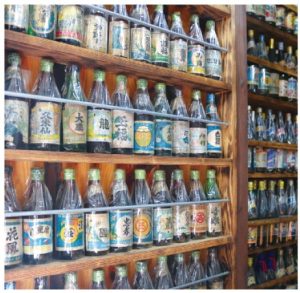
Additionally, in 1853, during his visit to Ryukyu, U.S. Navy Commodore Matthew Perry recorded an event at a banquet. He noted that “a liquor with a taste similar to French liqueur was served in very small cups.” His accompanying secretary, Bayard Taylor, described the liquor as “far more flavorful than any previously tasted on the island. It was old, mellow, and had a thick, sweet texture that resembled French liqueur.”
During the Meiji era, the reputation of awamori grew even further, reaching a point where over 700 awamori distilleries were established within Okinawa Prefecture at one time. By the Taishō era, its acclaim had risen even more, and demand outstripped supply, leading to a proliferation of counterfeit awamori on the mainland, which troubled those involved in the industry.
However, awamori suffered even more devastating damage during the final stages of World War II due to the intense ground battles in Okinawa, described as a “storm of iron.” The artillery bombardments destroyed Shuri’s awamori distilleries, causing the loss of almost all of their centuries-old stocks. During the subsequent 27 years of U.S. military occupation, American policies led to an influx of cheap imported whiskey into Okinawa. As a result, awamori came to be disparaged as “liquor for the poor” and “low-class liquor.”
In the late 1960s, as the movement for Okinawa’s reversion to Japanese sovereignty gained momentum, there was a parallel call for the revival of awamori, the highest-quality distilled liquor produced in Okinawa. Following Okinawa’s reversion to Japan in 1972, distillers, consumers, and local authorities united to revitalize awamori, and over the following fifty years, it has managed to recover to its present status .
The history of awamori encompasses two significant periods: a 500-year legacy as one of Japan’s premier distilled spirits and a 50-year resurgence following its temporary decline after World War II, continuing to evolve and thrive today.
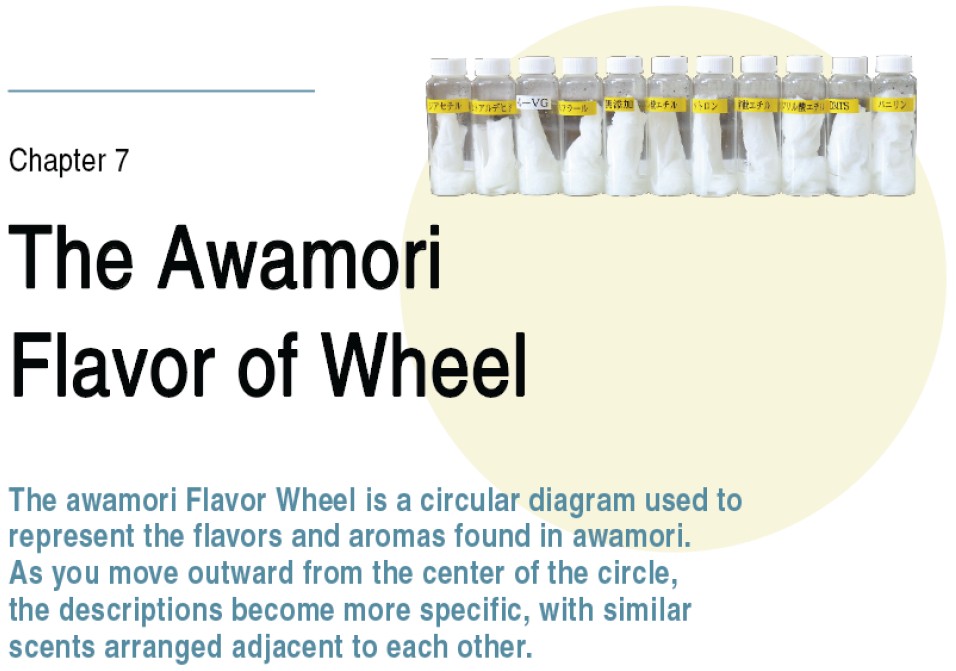
While there are similar flavor expression systems for other types of alcohol, the distinctive feature of the Awamori Flavor Wheel is its focus on fundamental aromas, rather than expanding the range of expressions.
The reason for narrowing the flavor descriptions is that if the same aroma is not described consistently, it becomes difficult to communicate effectively. For instance, if a scent combines vanilla, nuts, and burnt notes, it might result in a chocolate-like aroma. If one person describes it as “vanilla, nuts, and burnt notes,” while another describes it as “chocolate,” a third party might receive entirely different impressions. Similarly, one person might perceive a scent as “melon,” while another might describe it as “cucumber” or “watermelon rind.” When people converse with such varied perceptions, they must mentally translate these descriptions to ensure coherent communication.
To reduce discrepancies in flavor descriptions, the Awamori Flavor Wheel eliminates complex aromas as much as possible, consolidates similar aroma terms, and narrows down the expressions to 49 terms. This allows producers, sellers, and consumers to describe awamori’s aroma using the same vocabulary.
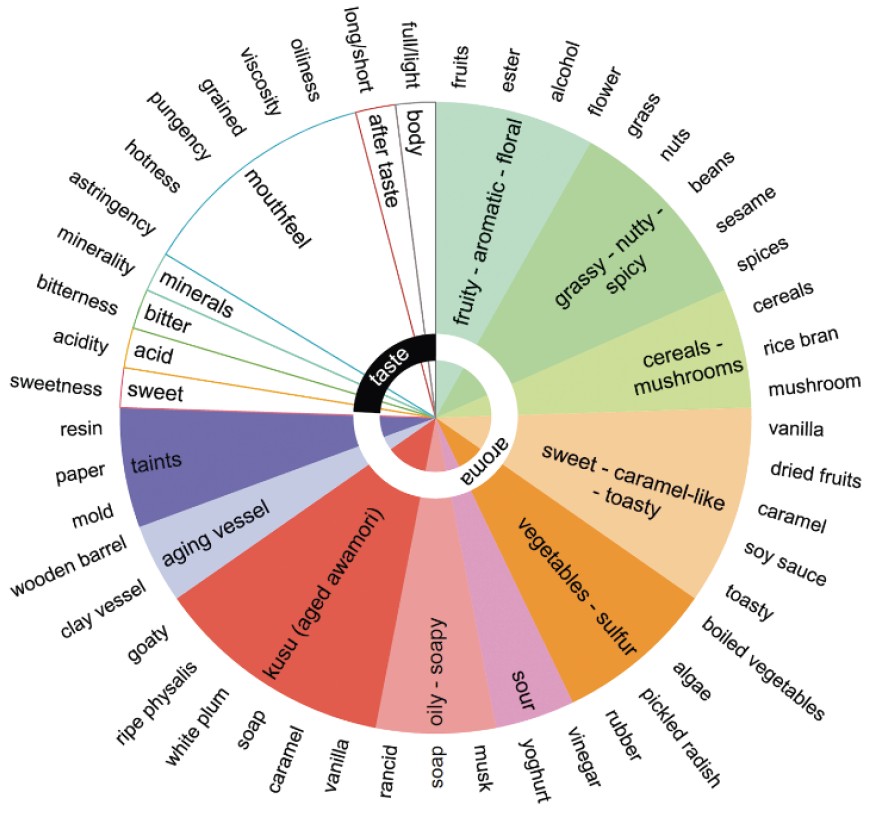
On the Awamori Flavor Wheel, 12 expressions related to “taste” are positioned in the upper left of the circle, while 37 expressions related to “smell” are placed elsewhere. Here, we will provide explanations for some of the less familiar aromas.
Ester:
This aroma evokes fruit scents such as “apple,” “pineapple,” and “banana.” When strong, it may also resemble adhesives or nail polish remover. Although not necessary to memorize, the chemical names associated with these aromas include “ethyl acetate,” “isoamyl acetate,” “ethyl caproate,” and “ethyl caprylate.”
Goaty, Ripe Physalis, White Plum:
The terms “goaty”, “ripe physalis,” and”white plum” fall under the category of aged liquor aromas. The exact nature of these scents is unclear, and they are not commonly used today. However, these terms were historically used by food connoisseurs to describe the aroma of aged liquor (Ku-su) before World War II. Most of such aged liquors were lost during the Okinawa Battle, and their specific aromas cannot be confirmed today. Nevertheless, these terms are included tentatively, as future technological advancements or the revival of very old aged liquors (100 or 200 years old)
might bring these aromas back into recognition.
Clay Vessel
This aroma, reminiscent of clay vessels, occasionally appears in liquors aged in ceramic jars.
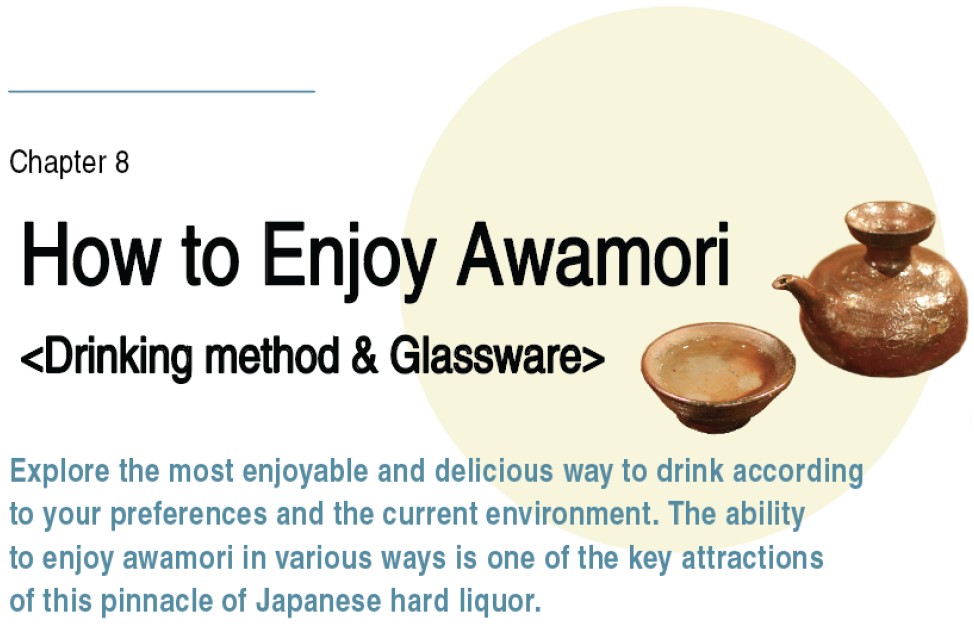
The most common ways to drink awamori are “mizu-wari” (diluted with water), “rock” (on the rocks), or “straight” (neat). Recently, “soda-wari” (diluted with sparkling water) is also becoming popular. Of course, there are no strict rules for how to enjoy awamori.
Mizu-wari (with ice): Place ice cubes in a glass, pour in the awamori, then add water and gently stir. For awamori at 30% alcohol by volume, mixing it with water in a 4:6 ratio will reduce the strength to about 12%. Adjust the dilution to your preference.
Mizu-wari (without ice): To avoid diluting the awamori over time with melting ice, use a water pitcher to chill the water or pre-dilute the awamori with water to your desired strength. This mixture can be left in the refrigerator overnight, a method known as “pre-dilution,” which some enthusiasts prefer.
Mizu-wari (float): Typically, awamori is poured into a glass before adding water to facilitate mixing. However, you can also pour awamori gently over water to create a “float” style. This allows you to enjoy the strong original flavor of the awamori first, followed by a milder, diluted taste as you drink.
Soda-wari: A recently popular method, adding sparkling water changes the aroma profile and provides a new perspective on the flavor of awamori.
Straight: Enjoy awamori without any additives to appreciate its pure flavor. For high-quality aged awamori, it is recommended to pour it into a small glass or cup, sipping slowly to savor its sweet aroma. Some enthusiasts also enjoy the lingering aroma in the empty glass afterward.
On the Rocks: Serve awamori over large ice cubes in a glass. This method is ideal for those who prefer a stronger flavor without dilution.
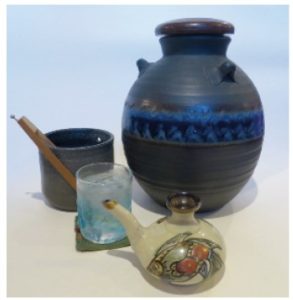
Partial Shot: Chill high-proof awamori in the freezer until very cold, then drink a small amount quickly. This technique takes advantage of the fact that high-proof awamori doesn’t freeze easily. Although it becomes easier to drink, the alcohol content remains unchanged, so drink responsibly.
Cocktails: Okinawa’s cocktail culture, including mixing awamori with various ingredients, has been established for over half a century, partly due to the American military occupation after World War II. Initially, carbonated beverages like cola and 7-Up were popular mixers. Over time, options such as jasmine tea and coffee have also become common. Awamori is sometimes mixed with sweetened condensed milk or dashi broth. Recently, for visual appeal, awamori is often infused with cut fruits or vegetables, creating a sangria-style drink.
Awamori, with its long history, has many distinctive drinking vessels designed for its enjoyment. Traditional drinking vessels include:
Karakara: A vessel that holds about 180ml of awamori.
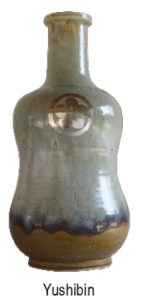
Yushibin (嘉瓶): A ceremonial bottle used for special occasions and celebrations.
Chibugwa (ちぶぐゎ―): A small cup used for drinking precious aged awamori.
Dachibin (抱瓶): A container worn around the waist for carrying awamori.
Oninoude (鬼の腕 / ウニヌティー): A vessel that holds approximately 900ml of awamori.
Some of these traditional drinking vessels are still used today, continuing to enhance the culture of awamori.
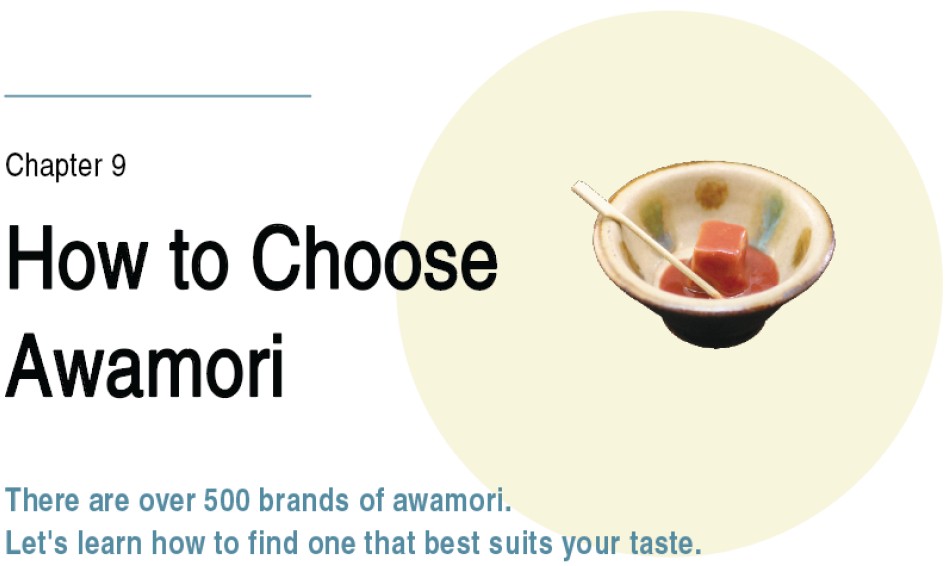
When you find yourself in a position to teach others about awamori, the most frequently asked question will likely be, “Which awamori is the best?” The answer to this question is that, since awamori is a matter of personal preference, the answer is “it depends on the individual.” However, understanding the different types of awamori based on their production methods can help find the awamori that tastes best for each person.
To assist with this, let’s review some key production points that significantly influence the flavor and aroma of awamori. In particular, “type of distillation,” “type of storage container,” “storage period,” and “filtration” are factors that have a considerable impact on the taste and are relatively easy to gather information about, making them useful for reference.
Distillation Type
There are two types of distillation: “vacuum distillation,” where the pressure in the pot is lowered to boil at a lower temperature, and “atmospheric distillation,” which is the traditional method. Vacuum distillation tends to produce awamori with a clean, crisp taste and prominent fruity or ester-like aromas. On the other hand, atmospheric distillation results in a richer, more robust flavor; a characteristic of traditional awamori. Preference between the two is a matter of personal taste. With experience, you can often distinguish between the two types of distillation just by smelling the aroma, so it’s helpful to try different awamori and become familiar with their characteristics.
Examples of atmospheric distillation include “Kumejima no Kumesen” and “Ryukyu Ouchou (Taragawa),” while examples of vacuum distillation include “Zanpa White (Higa Shuzo)” and “Ender (Mizuho Shuzo).”
Type of Storage Container
After distillation, awamori is typically stored for several months to stabilize its quality before being shipped. The type of container used for storage can greatly affect the flavor of the awamori. Various storage containers include earthenware jars (clay pots), barrels, and stainless steel tanks. Particularly, when stored in wooden barrels, the resulting awamori often has a distinctive aroma that combines the scent of the barrel with the sweet aroma of the awamori. Examples of barrel-aged awamori include “Danryu (Kamimura Shuzo)” and “Kura (Helios Shuzo).”
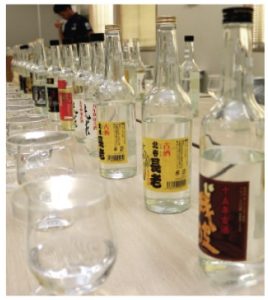
Storage Period
As it ages, awamori tends to develop a mellow, sweet aroma reminiscent of vanilla or caramel (known as “koshu aroma”). Industry standards allow labeling as “Ku-su (“Koshu” in Japanese, both means aged awamori), if the storage period exceeds three years. However, the time it takes for rich Ku-su aromas to develop can vary based on the characteristics of the raw awamori and the storage environment, sometimes more than three years of aging would be necessary. To confirm the characteristics of aged awamori available commercially, consider trying award-winning entries from the Awamori Evaluation Conference (Awamori Appraisal), hosted by Okinawa Prefecture and the Okinawa National Tax Agency. Awamori that has won the “Okinawa Governor’s Award” or the “Okinawa National Tax Agency Director’s Award” often exhibits such traits.
Filtration
The extent and type of filtration before bottling significantly affects the flavor of the final product. Generally, filtration is done to improve the smoothness of the taste, but some awamori deliberately avoids filtration to express the natural strength of the original spirit. Such awamori often has labels indicating “coarse filtration (Ara-roka)” or “unfiltered(Muroka).”
Other Factors
While not necessarily the primary determinants of awamori flavor, factors such as yeast, raw rice, koji-making time, and the type of black koji mold are noteworthy. Typically, “101 yeast” is used, but sometimes different types are selected, such as brown sugar yeast (Aka no Matsufuji / Matsufuji Shuzo), Hojun yeast (Hojun Roman / Kamimura Shuzo), or mango yeast (Chuko Genshu / Chuko Shuzo). Most awamori producers use Thai long-grain rice, but some use short-grain rice from mainland Japan (Udeisan no Sake / Miyano Hana Shuzo) or long-grain rice from Okinawa (Terushima 43-degree Iheya’s Long-Grain Rice / Iheya Shuzo). The koji-making process usually takes about two days, but some, like the three-day koji (Matsufuji / Matsufuji Shuzo), extend this to three days or more. Different types of black koji mold, such as Awamori, Saitoi, and Inui, are used for various purposes.
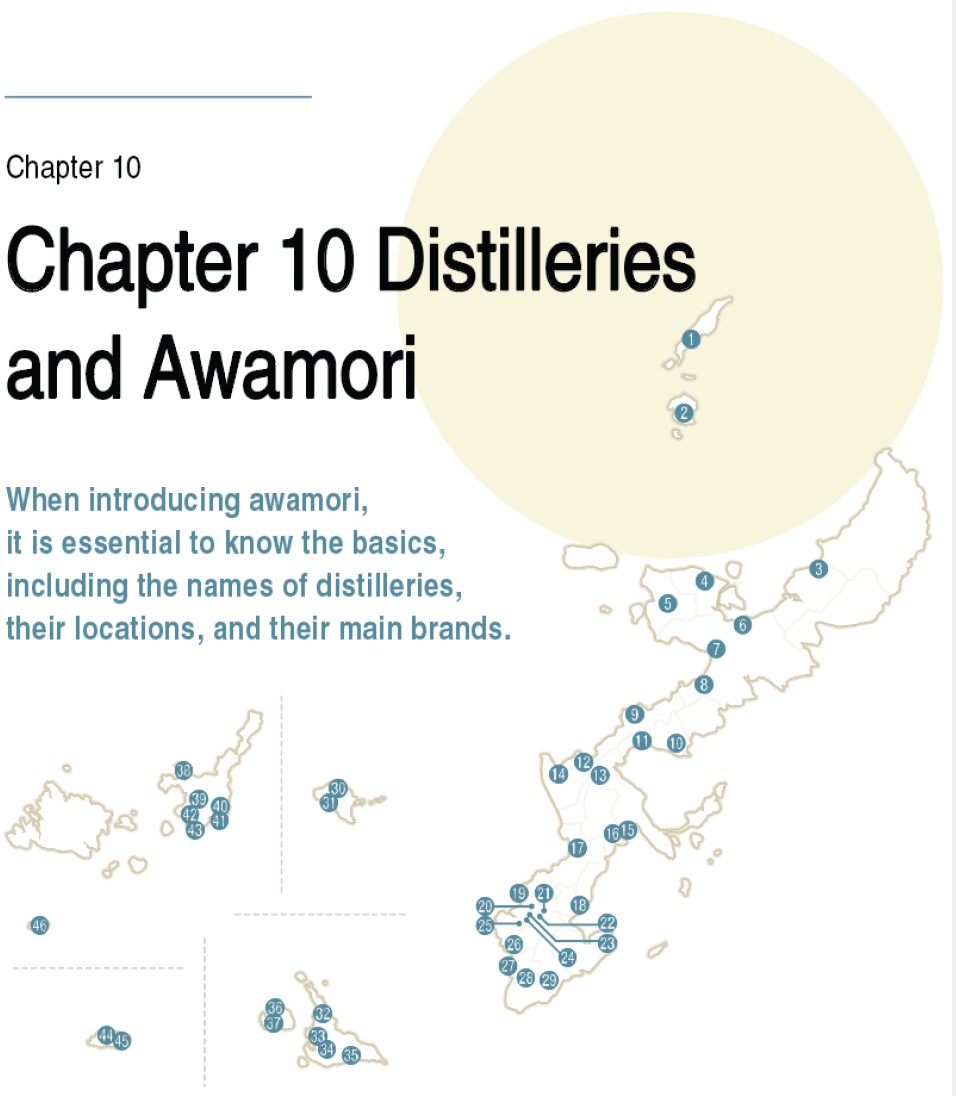
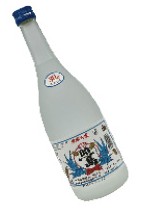
Founded in 1948 / Atmospheric Distillation
Address: 2131-40 Gakiya, Aza, Iheya Village
TEL: 0980-46-2008
The company was established as an alcohol production association by 22 islanders. In 1974, the association was dissolved, and the management was transferred to Mr. Hokumura. In 1988, the company relocated to its current location. They use spring water as the brewing water. Iheya Island is also a production area for rice (long-grain type), and they produce awamori made from domestic long-grain rice. Their main products are "Terushima" and "Shimagumi."
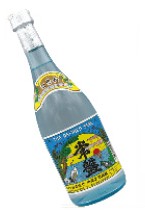
Founded in 1949 / Atmospheric Distillation
Address: 736 Izena, Aza, Izena Village
TEL: 0980-45-2089
Izena Island, located in the northern part of Okinawa's main island, is the birthplace of Ryukyu King Shōen. The aged awamori "Kanemaru" from Izenam Shuzo is named after Shōen's childhood name. Izena Island is rich in underground water sources and is also a major rice producing area. The primary brands include "Tokiwa," "Izenajima," and "Shōen no Sato."
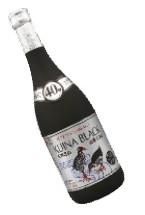
Founded in 1950 / Atmospheric Distillation
Address: 417 Takazato, Aza, Ohgimi Village
TEL: 0980-44-3297
The company was founded as Takazato Shuzo and changed its name to Yanbaru Shuzo in 2017. Located at the northernmost tip of Okinawa's main island, the distillery produces "Yamanba Kueina" and "Maruta" awamori using the rich natural spring water of the Yanbaru region. In addition to their awamori, they have many fans of Ayako Ikehara, known affectionately as "Maruta Musume," who is an award-winning awamori blender.
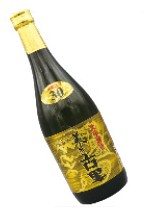
Founded in 1948 / Atmospheric, Vacuum Distillation
Address: 500 Nakasone, Aza, Nakijin Village
TEL: 0980-44-3297
The company was founded as Oshiro Shuzo and changed its name to Nakijin Shuzo in 1972. It produces awamori such as "Marudai," "Nakijin Castle," and "Sen-nen no Hibiki." The "Uruwashiki Furusato," with an alcohol content of 20%, was a pioneering product in the mild awamori style that emerged after Okinawa's reversion to Japan.
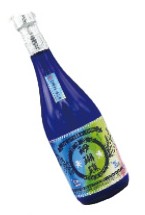
Founded in 1946 / Atmospheric Distillation
Address: 58 Namizato, Aza, Motobu Village
TEL: 0980-47-2136
At the foot of Mt. Yaedake, the company is renowned for its dedication to producing aged awamori and is known by the nickname "Ku-su no Yamakawa" (The Aged Liquor of Yamakawa). In 2017, they gained considerable attention with the release of the 50-year-old awamori, "Limited Reserve Kaneyama 1967." Their main brands include "Sango-sho," "Sakura Ichiban," and "Kaneyama Awamori."
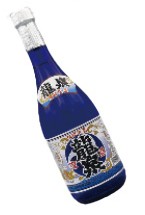
Founded in 1939 / Atmospheric Distillation
Address: 222 Nakaoshi, Aza, Nago City
TEL: 0980-58-2401
The company was founded by acquiring a brewing license from a distillery in the Yaeyama region and was initially established as Haneji Shuzo. It changed its name to Ryusen Shuzo in 1975. Its flagship product is "Ryusen." In 2013, the company came under the umbrella of JCC Corporation. Although located in the northern part of Okinawa, several restaurants specializing in "Ryusen" are found in the southern part of the island as well.
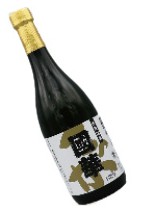
Founded in 1924 / Atmospheric Distillation
Address: 1-14-6 Ohnaka, Nago City
TEL: 0980-52-2070
The distillery, constructed in 1928, features a wooden structure with a tiled roof, integrating residential and brewing facilities. It preserves the architectural form of the distillery from the early Showa period. Due to its historical significance, the main building of the distillery was designated as a National Important Cultural Property in 2009. After World War II, it was repurposed as a U.S. military bread factory. The distillery’s primary brand is "Kokka."
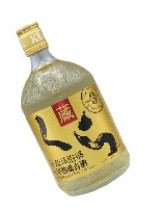
Founded in 1961 / Atmospheric, Vacuum Distillation
Address: 405 Kyoda, Aza, Nago City
TEL: 0980-52-3372
Founded as Taiyo Brewing, specializing in rum production from Okinawan sugarcane, the company changed its name to Helios Distillery in 1969. In 1979, it began producing awamori. The distillery has a broad range of products, including whiskey, rum, beer, and liqueurs. Its main brands are "Kura" and "Todoroki."
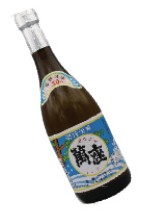
Founded in 1949 / Atmospheric Distillation
Address: 2690 Onna, Aza, Onna Village
TEL: 098-966-8105
The company was founded with the investment of ten local residents. Located near the renowned scenic spot Manzamo, it produces the widely loved Ryukyu Awamori named "Manza." In 2020, they opened a sales outlet within the newly completed Manzamo area revitalization facility.
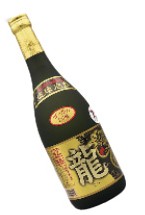
Founded in 1949 / Atmospheric Distillation
Address: 4823-1 Kin, Aza, Kin Town
TEL: 098-968-2438
In the water-rich town of Kin, the distillery uses hard water from the Kin-Ogawa river system for brewing, while soft water is used for dilution to produce their awamori brand "Tatsu" (Dragon). The name "Tatsu" is inspired by the Chinese zodiac signs of the founder's predecessors. In 1988, they began storing awamori in a unique underground aging facility, a limestone cave known as "Tatsu-no-Kura," located 30 meters underground and extending 270 meters in length.
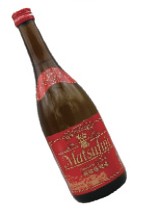
Founded in 1905 / Atmospheric Distillation
Address: 751 Igei, Aza, Kin Town
TEL: 098-968-2417
The company was founded in Shuri-Tori-bori. In 1946, Mr. Kimatsu Sakiyama, the second-generation owner, became the factory manager at a government-owned production facility in Igei, Kin Town. The company was privatized in 1949. In 2020, it changed its name to Matsufuji. The flagship product, "Matsufuji," is named after Kimatsu and his wife Fujiko. It is often chosen as a gift due to its auspicious associations with matchmaking and good fortune.
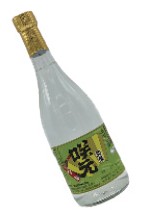
Founded in 1902 / Atmospheric Distillation
Address: 1437-1, Yamada, Aza, Onna Village (Within the Ryukyu Village facility)
TEL: 098-963-0208
The company was originally founded as Sakumoto Shuzojo. In 1949, it changed its name to Sakimoto Shuzo. After suffering devastating damage during the Okinawa Battle, they discovered black koji mold on a traditional straw mat (nikubuku) in the burnt-down facility. This discovery led to the revival of Shuri-style awamori. In 2020, the company relocated to the Ryukyu Village in Onna Village. Their main brands are "Sakimoto" and "Kuhaha."
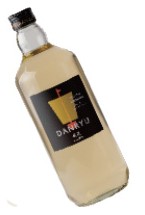
Founded in 1882 / Atmospheric Distillation
Address: 570 Kadekaru, Ishikawa, Uruma City
TEL: 098-964-7628
The company was founded in Hantagawa, Naha City. After World War II, it operated as a government-owned factory. In 1999, it relocated to Uruma City. Since 1968, their "Danryu" has become a symbolic name for barrel-aged awamori. The carbonated version of Danryuu is affectionately known as "Dan-ball." Besides the high quality of their awamori, many fans are also captivated by the passion and personality of the distillery’s staff members.
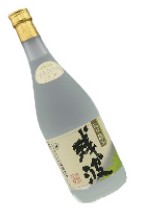
Founded in 1948 / Atmospheric, Vacuum Distillation
Address: 1061 Nagahama, Yomitan Village
TEL: 098-958-2205
While respecting tradition, the company remains a leader in the industry with its forward-thinking approach. The "Zanpa" series, launched in 1980, quickly expanded its market share with its smooth taste and vibrant aroma. It continues to be a long-selling favorite to this day.
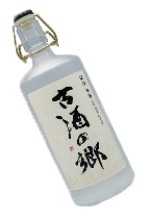
Founded in 2008 / Storage and Blending Facility
Address: 5193-27 Haebaru, Katsuren, Uruma City
TEL: 098-939-6072
Founded as a cooperative of 42 distilleries within the prefecture, it specializes in aging and selling awamori. Using tanks with a capacity of 51,000 liters, they blend raw spirits from multiple distilleries and then age them into Ku-su. Their main brand is "Ku-su No Sato".
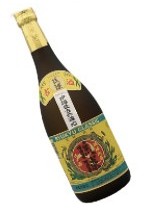
Founded in 1846 / Atmospheric, Vacuum Distillation
Address: 3-22-8 Koja, Okinawa City
TEL: 098-939-5050
Founded in Shuri, the company moved to Koja in Okinawa City in 1988. In 2006, they constructed a new factory in Suzaki, Uruma City. The fourth-generation owner, Shuichi Shinzato, is renowned for developing a yeast strain that produces minimal foam during brewing. Their main brands are "Ryukyu" and "Kariyushi." In recent years, they have also focused on whiskey production.
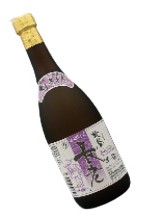
Founded in 1848 / Atmospheric Distillation
Address: 63 Yoshihara, Chatan Town
TEL: 098-936-1239
The company was originally founded in Shuri. In 1910, it moved to Kuwae in Chatan Town. After World War II, the Kuwae distillery was requisitioned for U.S. military base land. Operations resumed in the 1940s at the current location under the name Tamanaha Shuzo. In 2006, the company changed its name to Chatan Choro Shuzo. Their main brands are "Chatan Choro" and "Ipponmatsu."
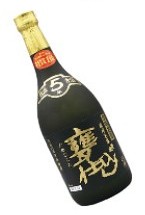
Founded in 1949 / Atmospheric Distillation
Address: 1438-1 Onaha, Aza, Nishihara Town
TEL: 098-945-3515
Founded in Shuri-Samukawa, the company moved to Onaha in Nishihara Town in 1990. It is one of the few distilleries that uses clay pots for producing awamori. In 1973, they developed "Moromi Su(Vinegar)" by extracting citric acid and amino acids from distillation lees. Yumiko Ishikawa received the Awamori Blender of the Year 2020 award. They produce brands such as "Kamejikomi", "Gyokuyu", and "Shimakaze."
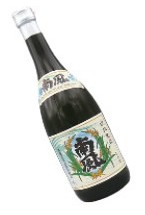
Founded in 1976 / Storage and Blending Facility
Address: 2-8-9 Minatomachi, Naha City
TEL: 198-945-3515
Founded with the goal of long-term aging and maturation of awamori, and ensuring stable distribution outside the prefecture, this cooperative includes all awamori producers in Okinawa Prefecture. They sell brands such as "Umi no Kuni," "Konpeki," and "Nanpu." The cooperative also supports distilleries by jointly purchasing materials like Thai rice (raw ingredients), bottles, and caps.
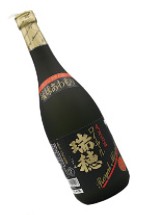
Founded in 1848 / Atmospheric, Vacuum Distillation
Address: 4-5-16 Sueyoshi Town, Shuri,Naha City
TEL: 098-885-0121
The oldest distillery in Shuri, known for its top-class technical expertise, Mizuho offers a comprehensive range of awamori production methods that can serve as a complete learning experience in the field. As a core distillery in the "Sho" development project, it played a key role in the creation of "Beyond 2022," which brought technological innovation to the industry. They produce brands such as "Mizuho," "Chura Sansan," and "Ender."
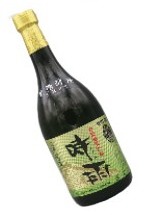
Founded in 1918 / Atmospheric Distillation
Address: 2-48 Akata Town, Shuri, Naha City
TEL: 098-884-5451
One of the remaining distilleries in Shuri. Since its founding, this establishment values traditional production methods and has meticulously continued to craft its flagship product, "Shigure". Amid the intensifying ground battles in Okinawa, two awamori jars that were buried deep underground for safekeeping miraculously survived and are still treasured as family heirlooms by the Shikina family. They produce the brands "Yorokobi" and "Shigure."
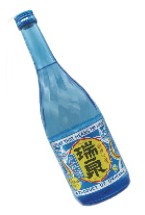
Founded in 1887 / Atmospheric, Vacuum Distillation
Address: 1-35 Sakiyama Town, Shuri, Naha City
TEL: 098-884-1968
Founded in Shuri as Kyan Shuzojo, the company became Sakumoto Masaatsu Shuzojo in 1935, and in 1957, it was reorganized as a limited partnership under the name Zuisen Shuzo Factory. In 1971, it changed its name to Zuisen Shuzo. In 1999, the company gained attention for producing awamori using pre-war black koji mold preserved at the University of Tokyo. Kazuaki Igei was awarded Blender of the Year 2021. They produce brands such as "Zuisen," "Omoro," and "Usaki."
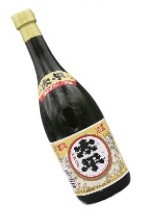
Founded in 1898 / Atmospheric Distillation
Address: 2-8-53 Yogi, Aza, Naha City
TEL: 098-832-3696
Aiming to create distinctive and flavorful awamori that becomes more profound with aging, the company puts significant effort and care into its production. Many aficionados of aged awamori appreciate Tsuhako Shuzo for its deep and nuanced flavors. The second-generation president named the brand " Taihei " with the hope for peace.
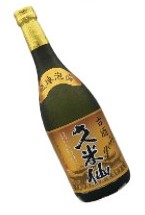
Founded in 1952 / Atmospheric, Vacuum Distillation
Address: 155 Nakaima, Aza, Naha City
TEL: 098-832-3133
Founded in Daido in Naha City. In 1986, the company relocated to Nakaima in Naha City. In 1978, the redesigned "Kumesen (Green Bottle)" gained popularity and sparked the awamori boom. Known for its pioneering spirit, the company began producing awamori in China (Inner Mongolia) in 1944 and launched the whiskey "Okinawa BLUE 8 Years" in 2022.
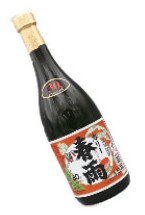
Founded in 1946 / Atmospheric Distillation
Address: 645 Oroku, Naha City
TEL: 098-857-3065
The company’s commitment to exploring and producing excellent awamori based on data is highly regarded among professionals in the beverage sales and distribution industry. The brand "Harusame" enjoys national recognition and has a large fan base. Its aged awamori was selected as a ceremonial liquor for the imperial family at the 1975 Okinawa International Ocean Exposition and was also chosen for toasting at the 2000 Kyushu-Okinawa Summit dinner.
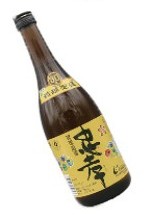
Founded in 1949 / Atmospheric, Vacuum Distillation
Address: 132 Nakachi, Aza, Tomigusuku City
TEL: 098-850-1257
The company began operations as Ohshiro Shuzo after taking over a distillery run by the village of Tomigusuku. In 1980, it changed its name to "Chuko Shuzo." The brand name "Chuko" is derived from the founder, Chuko Ohshiro’s name. To age its awamori, the company manufactures its unique clay jars, functioning both as a distillery and a kiln. They produce brands such as "Chuko" and "Yume Koukai."
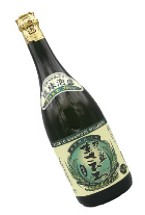
Founded in 1883 / Atmospheric, Vacuum Distillation
Address: 5-8-7 Nishizaki Town, itoman City
TEL: 098-994-8080
The company was originally founded as Higa Shuzo in Shuri. It moved to Yonabaru Town in 1949, to Shuri Ishimine in 1967, and to Nishizaki in Itoman City in 1991. In 2015, it was renamed Masahiro Shuzo. The brand name "Masahiro" is derived from the name of the 3rd owner, Masahiro Higa. The distillery also features the "Awamori Masahiro Gallery," where its impressive collection of bottles is on display.
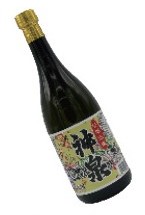
Founded in 1947 / Atmospheric Distillation
Address: 1061 Zaha, Aza, Itoman City
TEL: 098-994-6320
At the rear of the distillery is a sacred spring known as "Nbugah," which is cherished and protected by the local community. The flagship brand "Shinsen" was named in gratitude for this water source. Since 1994, the distillery has utilized electronic techniques (carbon burial and electron generation devices) to ensure product quality. In 2021, the business was succeeded by Nanto Co., Ltd.
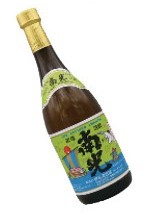
Founded in 1949 / Atmospheric, Vacuum Distillation
Address: 510-3 Yonagusuku, Aza, Yaese Town, Shimajirigun
TEL: 098-998-2108
Founded in Kochinda, the distillery relocated to its current location in Yaese Town in 2004. In a lush and tranquil environment, they aim to produce awamori with a simple and gentle flavor. Their flagship brand, "Nanko," was named to be a beacon of hope for the southern region in the chaos following the end of World War II.
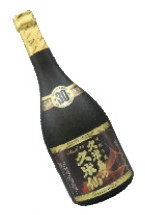
Founded in 1949 / Atmospheric Distillation
Address: 2157 Uegusuku, Aza, Kumejima Town, Shimajiri Gun
TEL: 098-985-2276
Founded on Kume Island as Nakazato Shuzo, the company changed its name to "Kumejima no Kumesen" in 1993. Renowned for its high quality and taste, it boasts one of the top production volumes in the prefecture. The flagship brand, "Kumejima no Kumesen", is named after the legend in which a sage would offer sake to villagers at dusk, soothing their day's fatigue.
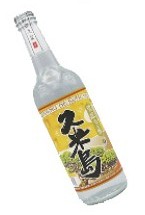
Founded in 1948 / Atmospheric Distillation
Address: 499 Ohta, Aza, Kumejima Town
TEL: 098-985-2326
The distillery is well-suited to the term "earnest." Using natural water from a pristine water system where fireflies thrive, they produce awamori with meticulous care and patience, earning high praise from connoisseurs. In addition to their exceptional Ku-su, they also craft deeply flavorful awamori. Their main products are "Chura Botaru," "Kumejima," and "Hoshi no Akari."
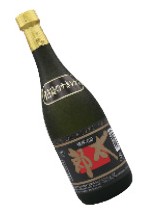
Founded in 1946 / Atmospheric Distillation
Address: 57 Nishihara, Aza, Taira, Miyakojima City
TEL: 0980-72-2425
In the northwest of Miyako Island, they produce "Niko Niko Taro." The name "Taro" is derived from the second-generation president, Taro Ikema, reflecting the wish for people to enjoy the awamori with a smile. The distillery values tradition and adheres faithfully to basic production methods, earning a strong following not only locally but also on the main island. Their Ku-su brand is "Zuiko."
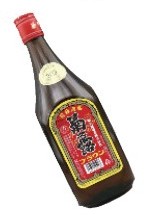
Founded in 1928 / Atmospheric, Vacuum Distillation
Address: 290 Nishizato, Aza, Taira, Miyakojima City
TEL: 0980-72-2669
Founded as Nakao Shuzo, the company changed its name to Kikunotsuyu Shuzo in 1965, adopting a character from the founder Kikujirou Nakao's name. The name "Kikunotsuyu" is inspired by a Chinese story where morning dew on chrysanthemum petals was said to cure illness, reflecting a desire for "health and longevity." The distillery boasts one of the largest reserves of aged awamori in the prefecture while also pioneering new production methods and leading the industry.
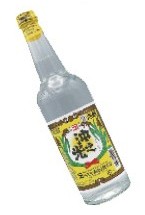
Founded in 1948 / Atmospheric Distillation
Address: 1174 Shimozato, Aza, Taira, Miyakojima City
TEL: 0980-72-2245
Founded by Tamekichi Koja as Koja Shuzojo, the company changed its name to Okino Hikari Shuzo in 1979, reflecting the intention to be a "beacon of light" for Okinawa. The main brand is "Okino Hikari." Despite its small size, the company has achieved efficient production through mechanization, offering a wide range of products from regular awamori to Ku-su.
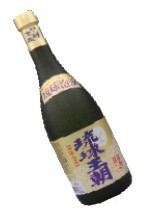
Founded in 1948 / Atmospheric Distillation
Address: 85 Sunagawa, Aza, Gusukube, Miyakojima City
TEL: 0980-77-4108
A distillery dedicated to crafting exceptional awamori with unwavering passion and attention to the drinker's experience. They use mineral-rich spring water from the foothills of Kami-hine in southern Miyako Island to produce their raw spirits. The nearby limestone cave, "Uibya Upusu Kura," serves as their facility for aging awamori. Their main brands include "Ryukyu Ouchou," "Taragawa," and "Kuon."
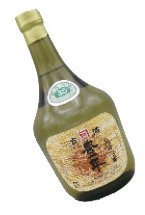
Founded in 1948 / Atmospheric Distillation
Address: 1500 Sawada, Aza, Irabu, Miyakojima City
TEL: 0980-78-3006
On Irabu Island, which you reach by crossing the 3.5 km long Irabu Bridge while gazing at the emerald green sea from Miyako Island, the local favorite awamori from Tokuyama Shuzo, including their well-loved "Hounen," has been enjoyed by island residents for many years. The distillery meticulously performs many processes by hand to produce richly aromatic awamori, and it has passionate followers not only islanders but also outside the island.
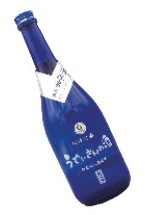
Founded in 1948 / Atmospheric Distillation
Address: 158-1 Nakachi, Aza, Irabu, Miyakojima City
TEL: 0980-78-3008
The representative brand "Miyano Hana" is named to become "like the Miyako blossom, which slowly continues to bloom in people's hearts." The commitment to using domestic rice as a raw material has a long history, and "Udeisan no Sake," which uses Kumamoto Prefecture's Hinohikari rice, is a representative example of mainland-sourced rice awamori.
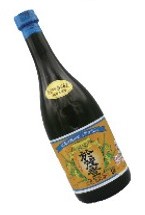
Founded in 1949 / Atmospheric Distillation
Address: 930-2 Kabira, Aza, Ishigaki City
TEL: 0980-88-2201
At the distillery overlooking the nationally designated scenic spot, Kabira Bay, many visitors come to observe the awamori-making process. The distillery is committed to handmade production at every stage, and the artisans' dedication to crafting awamori is truly beautiful. The awamori distilled using traditional direct-fire pot stills, such as "Omoto" and "Kabira," is robust and rich in flavor. These are also highly recommended as awamori for aging into Ku-su.
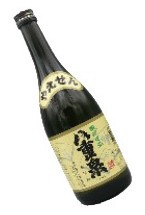
Founded in 1955 / Atmospheric, Vacuum Distillation
Address: 1834 Ishigaki, Aza, Ishigaki City
TEL: 0120-8000-32
Founded in Ishigaki City, the company relocated to its current new factory in 1991 (located in Ishigaki City, Ishigaki). The factory, situated on a small hill overlooking the sea and islands of the Yaeyama region, operates with the philosophy of "滴滴在心" (each drop made with heartfelt dedication). They produce awamori with meticulous care. The main brands include "Yaesen," "Kuro Shinjyu," and "Shima Urara."
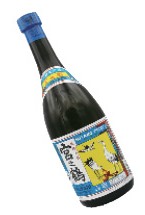
Founded in 1948 / Atmospheric Distillation
Address: 956 Miyara, Aza, Ishigaki City
TEL: 0980-86-7047
Since its founding, the distillery has continued to produce awamori beloved by the local community. The main brand is "Miyano Tsuru," named after Miyara, the location of Nakama Shuzo. Due to its limited production, Miyano Tsuru is often not available outside the island. It is the smallest awamori distillery in Okinawa Islands.
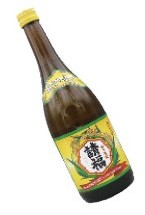
Founded in 1949 / Atmospheric, Vacuum Distillation
Address: 959 Miyara, Aza, Ishigaki City
TEL: 0980-84-4118
Originally founded as Kanna Shuzō, the company changed its name to Seifuku Shuzō in 1992. While preserving traditional awamori production methods, the distillery also focuses on creating liqueurs with additions such as yuzu, grapefruit, and ginger lemon. They are known for their innovative practices, including the production of rice vinegar from awamori distillation residues and Imugē, which is made from sweet potatoes and brown sugar.
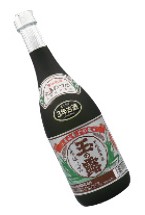
Founded in Meiji late period / Atmospheric Distillation
Address: 47 Ishigaki, Aza, Ishigaki City
TEL: 0980-82-3165
Established as a branch of a distillery from Shuri, this distillery was founded in Yaeyama and is recognized as the oldest distillery in the region. Although the distillery was destroyed during the Battle of Okinawa, the passion for alcohol production has been passed down through generations. They continue to produce traditional awamori, including those suitable for aging. The main brand is "Tama no Tsuyu."
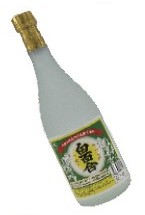
Founded in 1951 / Atmospheric Distillation
Address: 175 Ohkawa, Aza, Ishigaki City
TEL: 0980-82-2230
Although it's a small distillery on Ishigaki Island, its reputation is recognized nationwide. The flagship product, "Shirayuri," has a dedicated fan base known as "Shirayurists." The distillery frequently collaborates with restaurants and musicians for events. The young representative of the distillery is energetically driving its activities forward with great enthusiasm.
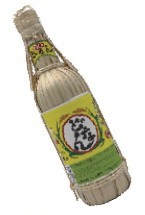
Founded in 1958 / Atmospheric Distillation
Address: 2087 Yonaguni, Aza, Yonaguni Town
TEL: 0980-87-2315
Originally a personal alcohol production endeavor, it was established as Kokusen Awamori Co., Ltd. The flagship brand, "Donan," is named after an old term for Yonaguni Island, reflecting its challenging maritime conditions (渡難, "Difficult Passage"). In 2011, the company moved to the suburbs, expanded its scale, and modernized its facilities. In 2023, the company changed its name to Donan Shuzō.
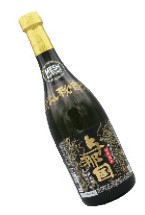
Founded in 1927 / Atmospheric Distillation
Address: 2329 Yonaguni, Aza, Yonaguni Town
TEL: 0980-87-2417
Seventeen local rice farmers invested to start the alcohol production business. By 1965, the number of investors had reduced to four, and in 1971, one of the investors, Hajime Sakimoto, established Sakimoto Shuzō as an independent entity. In 2006, the company relocated to a site near the top of Tindahanata. They continue to produce awamori using traditional old-style pot stills. The main brands are "Yonaguni," "Uminami," and "Hagoe."
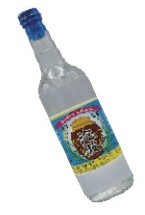
Founded in 1950 / Atmospheric Distillation
Address: 156 Hateruma, Aza, Taketomi Town
TEL: 0980-85-8332
On the southernmost island of Japan, Hateruma Island, the awamori named "Awanami" was created by combining one character from "awamori" and one from "Hateruma." Due to its primary consumption on the island, it is quite difficult to obtain outside of Hateruma. The distillery not only produces awamori but also serves as a cultural hub for the island, with the staff taking on dual roles of both alcohol production and managing local events.

